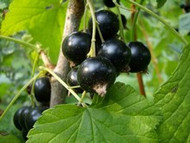How To Grow Blackcurrants

Blackcurrants are easy-to-grow bushes that produce bunches of dark purple to black fruits in mid-summer. They have a tart flavour, are an invaluable source of vitamin C and can be used in pies and jams and to make cordials and cassis.
Site and Soil
Blackcurrants tolerate a wide range of soil conditions, but prefer well-drained, moisture-retentive conditions. They need a rich, heavy soil. Blackcurrants prefer full sun, but will tolerate light shade. Avoid frost pockets – frosts can drastically reduce yields, even on some modern cultivars that are later flowering.
Buying and Planting
Always buy certified stock to avoid virus problems. One bush should yield about 4.5kg (10lb) of fruit. Grow blackcurrants as stooled, or multi-stemmed, bushes. In small gardens, blackcurrants can be grown in containers. Plant bare-root blackcurrants in late autumn; containerised plants can be planted at any time of year as long as the soil is not too wet.
 A few weeks before planting, clear the soil of all perennial weeds and enrich it with a generous amount of well-rotted manure. Add a compound balanced fertiliser at the rate of 85g per sq m (3oz per sq yd).
A few weeks before planting, clear the soil of all perennial weeds and enrich it with a generous amount of well-rotted manure. Add a compound balanced fertiliser at the rate of 85g per sq m (3oz per sq yd).
Dig a hole at least twice the circumference of the pot in which the blackcurrant was purchased if not bare-root. Space blackcurrant bushes 1.8m (6ft) apart. Add controlled-release fertiliser like Seafeed seaweed and poultry manure pellets on poor soils for individual plants if compound fertiliser wasn’t added when preparing the soil.
Set each plant at least 6cm (2.25in) deeper than it was previously, so it develops into a multi-stemmed stool bush. Deep planting encourages young, vigorous shoots to develop from the base. Mix the soil from the hole with well-rotted organic manure and backfill the hole. Firm it in well before watering.
When planting container-grown blackcurrants from mid-autumn until late spring, cut all the stems back to one or two buds above ground level to encourage strong shoots to develop from the base. If planting between early summer and early autumn, wait until the plant is dormant before pruning all the stems.
Plant Care
Water blackcurrants during dry periods in the growing season. Hand weed and mulch around the plant in late winter using well-rotted manure to suppress weeds. Avoid hoeing near the base of the bush because the hoe might cut through new shoots developing at the base of the plant. Re-pot container-grown blackcurrants every two or three years. Pot back into the same container or one slightly larger. Trim back some of the roots and tease away the old soil replacing it with fresh John Innes No 3 Compost.
 Training & Pruning
Training & Pruning
Prune blackcurrants when dormant – from late autumn to late winter. Bushes fruit on the young wood, mainly from one- or two-year-old stems, and it is important to bear this in mind when pruning.
Up to and including the fourth year after planting, remove weak, wispy shoots, retaining a basic structure of six to 10 healthy shoots. After year four, cut out about one-third of the older wood at the base, using a pair of loppers or a pruning saw. This will encourage and make room for younger, healthy wood. Also remove weak shoots and low ones leaning towards the ground
Pests and Diseases
Blackcurrants are prone to attack by birds, so cover the plants with taut netting as the fruits ripen.
American gooseberry mildew: Flower frost damage and fungal leaf spots and mildew can also cause problems, as can the following more specific problems.
Big bud mite: These mites infest the buds of blackcurrant bushes. ‘Ben Hope’ is a resistant cultivar.
Blackcurrant gall midge: Tiny, white maggots feed on the shoot tips of blackcurrants, preventing leaves from reaching their full size; affected leaves dry up and die. Shoot tips can also die back. There is no cure available to the home gardener. Cultivars such as ‘Ben Connan’ and ‘Ben Sarek’ are resistant to blackcurrant gall midge.
Capsid bugs: These green insects suck the sap and cause small holes to appear on the leaves, which sometimes develop reddish brown spots. Spray with pyrethrum as soon as the symptoms are noticed.
Reversion: This virus is usually transmitted by big bud mite. It causes the leaves to turn yellow, and flowering and yields are dramatically reduced. There is no cure for this problem and plants should be removed immediately. Always buy certified virus-free plants.
 Harvesting
Harvesting
Harvest the fruit on modern varieties such as the Ben series by cutting the strigs (bunches of fruit) as they turn black. Older types of blackcurrant varieties ripen at different times, with the currants at the top of the strig ripening first. The fruit should therefore be picked individually.
Eat fresh blackcurrants within a few days of harvesting. Alternatively, they can be frozen, cooked, or made into jam or jelly.

